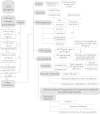A database for curating the associations between killer cell immunoglobulin-like receptors and diseases in worldwide populations
- PMID: 23584834
- PMCID: PMC3625957
- DOI: 10.1093/database/bat021
A database for curating the associations between killer cell immunoglobulin-like receptors and diseases in worldwide populations
Abstract
The killer cell immunoglobulin-like receptors (KIR) play a fundamental role in the innate immune system, through their interactions with human leucocyte antigen (HLA) molecules, leading to the modulation of activity in natural killer (NK) cells, mainly related to killing pathogen-infected cells. KIR genes are hugely polymorphic both in the number of genes an individual carries and in the number of alleles identified. We have previously developed the Allele Frequency Net Database (AFND, http://www.allelefrequencies.net), which captures worldwide frequencies of alleles, genes and haplotypes for several immune genes, including KIR genes, in healthy populations, covering >4 million individuals. Here, we report the creation of a new database within AFND, named KIR and Diseases Database (KDDB), capturing a large quantity of data derived from publications in which KIR genes, alleles, genotypes and/or haplotypes have been associated with infectious diseases (e.g. hepatitis C, HIV, malaria), autoimmune disorders (e.g. type I diabetes, rheumatoid arthritis), cancer and pregnancy-related complications. KDDB has been created through an extensive manual curation effort, extracting data on more than a thousand KIR-disease records, comprising >50 000 individuals. KDDB thus provides a new community resource for understanding not only how KIR genes are associated with disease, but also, by working in tandem with the large data sets already present in AFND, where particular genes, genotypes or haplotypes are present in worldwide populations or different ethnic groups. We anticipate that KDDB will be an important resource for researchers working in immunogenetics. Database URL: http://www.allelefrequencies.net/diseases/.
Figures



References
-
- Ljunggren HG, Karre K. In search of the ‘missing self': MHC molecules and NK cell recognition. Immunol. Today. 1990;11:237–244. - PubMed
-
- Moretta L, Biassoni R, Bottino C, et al. Human NK-cell receptors. Immunol. Today. 2000;21:420–422. - PubMed
-
- Liu WR, Kim J, Nwankwo C, et al. Genomic organization of the human leukocyte immunoglobulin-like receptors within the leukocyte receptor complex on Chromosome 19q13.4. Immunogenetics. 2000;51:659–669. - PubMed
-
- Wende H, Colonna M, Ziegler A, et al. Organization of the leukocyte receptor cluster (LRC) on human Chromosome 19q13.4. Mamm. Genome. 1999;10:154–160. - PubMed
Publication types
MeSH terms
Substances
LinkOut - more resources
Full Text Sources
Other Literature Sources
Research Materials

